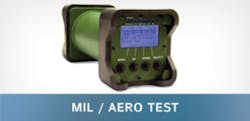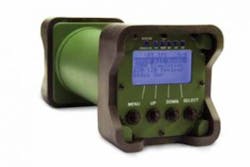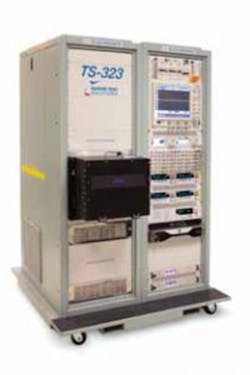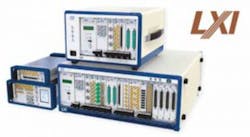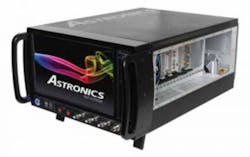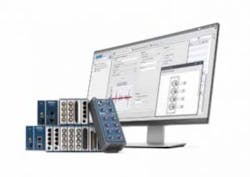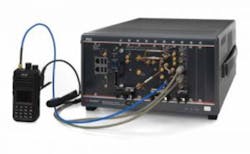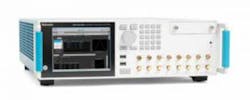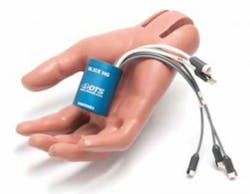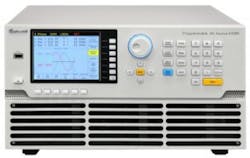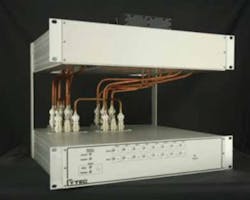Tackling test challenges across multiple programs and generations
Test engineers involved in military/aerospace applications face many challenges. They find themselves addressing generations of weaponry while maintaining and updating legacy test equipment. As in every application area, they face the need to pack more functionality into smaller configurations, while meeting the ongoing digital transformation’s demands for ever more data acquisition, processing, and storage. And of course, they need to control costs through the deployment of COTS (commercial off the shelf) systems while committing to long-term support.
Autotestcon, scheduled for Sept. 17-20 in National Harbor, MD, will give companies an opportunity to highlight their test products that can help customers meet the challenges of MIL/aero test applications. There, you can expect to see products ranging from Marvin Test Solutions’ hand-held MTS-3060 SmartCan universal O-Level armament test set (Figure 1) to Tektronix’s 5 Series Mixed-Signal Oscilloscope Low Profile, which offers high measurement density for production ATE applications (Figure 2).
“Customers are faced with increasingly complex and sophisticated aircraft and munitions which, in turn, require innovative test solutions that can maintain and diagnose problems in these complex systems,” said Major General Stephen T. Sargeant, USAF (Ret.), CEO of Marvin Test Solutions. “In addition, many of these same customers face major obsolescence issues as they are being asked to extend the life cycle of existing aircraft and their munitions—putting further demands on test engineering staff and test-set assets. MTS’s focus is on delivering solutions and tools enabling common test solutions that can provide support across multiple aircraft platforms at all maintenance levels, thus streamlining logistics. Additionally, we continue to make substantial investments in software tools and methods that facilitate test-program migration, helping to mitigate the challenge of maintaining and supporting legacy test systems.”
Continued Sargeant, “There is a clear trend to consolidate test solutions across multiple platforms by creating common solutions, thereby reducing the footprint of test. Historically, the use of a common test platform has been confined to depot test, but this concept is now moving to the flightline and backshop with programs such as BAT (Bomber Armament Tester), which will support all three USAF bomber platforms at both the O-Level and the I-level environments. We expect the use of a common test platform for fighter aircraft, as well as other aircraft, and munition systems to expand in the near future.”
Bob Stasonis, sales and marketing director at Pickering Interfaces, identified several trends in military/aerospace test, including VXI to PXI migration—involving the updating of old systems to PXI with the same functionality and supporting those applications for long-term. He said he also sees a need for higher density. “As space for test gear on a ship, for example, is limited, compact switching is a must,” he said. “Portability is also of great interest. So our focus is to provide as much switching per module as the laws of physics allow and also to provide compact chassis, like our new 1U, 6-slot chassis.”
Stasonis also noted that many prime contractors are outsourcing test to third parties. “So, switching vendors need to be in more places than ever before to close the business,” he said. In addition, there are an increased number of programs to follow. “Between migration of older designs and the ever more complex devices used for defense, there is a lot of opportunity out there,” he said.
The trend toward COTS is also continuing. “The days of custom instrumentation for MIL/aero programs are, for the most part, not feasible anymore,” Stasonis said. “The military and the primes all want commercially available products so long as they meet the necessary specifications. This saves them time to develop a system and also lowers the cost of test. Fortunately, all of our products are COTS. In addition, we offer very long-term support. In most cases, we will sell and support a product for 15 years or more.”
Stasonis said he also sees trends toward higher voltage (greater than 1 kV) and toward expanding fault-insertion requirements, with increased channel count as well as the number of fault lines required. “Our BRIC fault-insertion matrix was designed to be scalable for these requirements,” he said.
Finally, Stasonis said, “There is a need to generate and capture higher-frequency signals, interpret more sophisticated protocols, and take advantage of USB 3.0’s speed and reliability. All of this adds up to providing test vendors the need to support faster and faster data and RF signals.”
Astronics Test Systems also identifies issues surrounding VXI test systems. According to Steve Fairbanks, senior director, marketing, products and instrumentation, challenges customers face include maintaining and protecting their investment in VXI-based test equipment. They are looking for test-equipment vendors to continue to provide and support VXI-based assets as well as to provide carriers that allow PXI assets to be used within existing VXI chassis with minimum retrofit engineering. Customers also face challenges regarding legacy test-system upgrades to allow TPS reuse on modern test-equipment hardware. “As the services continue to extend the useful life of fielded platforms, the test equipment eventually becomes obsolete,” Fairbanks said. “We have provided modern systems that either utilize the legacy TPS software or validate new software that meets the legacy requirements.” Finally, he said, customers face challenges in testing legacy equipment as well as new technologies.
Fairbanks also identified two trends. “From the maintainer’s perspective, keeping existing testing equipment running reliably and keeping up with repair demands is the major concern,” he said. And from a new-system developer’s perspective, it’s necessary either to provide test systems that minimize or resolve legacy maintenance issues with existing platform architectures or to develop new architectures that fundamentally change the approach to achieve those ends.
Ben Robinson, aerospace and defense solutions marketer at National Instruments, identified yet another trend. “Electrification of systems continues to increase the number of test parameters and complexity of test systems in aerospace and defense,” he said. “This trend of test complexity will continue as the ongoing digital transformation requires more data collection, movement, storage, and processing, especially as the electromagnetic battlefield evolves, as we are seeing play out in Syria.”
In addition, Robinson said, “Test engineers in aerospace and defense constantly face compressed test schedules that must be met with smaller teams and rising costs as the equipment necessary to support legacy systems ages and becomes more expensive to operate. NI tools help engineers build more reusable and sustainable test solutions that can be maintained, extended, and operated more efficiently.”
According to Ryan Jones, senior technical marketing engineer at Corelis, “MIL/aerospace customers are looking for tighter integration between their test instruments so they can build feature-rich test systems geared toward improving test efficiency, reducing logistical footprints, and reducing maintenance costs. This means integrating boundary-scan systems into functional testers instead of using a separate benchtop system and ensuring that the system is reliable and ready for any level of test operator to run. Additionally, they are looking for ways to reduce no-fault-found (NFF) cases where a unit is returned from the field but passes functional tests. Corelis boundary-scan tools can provide structural diagnostic fault coverage on these units at the net and pin level that functional test may not detect, allowing units to be repaired and returned to the field with confidence.”
Mark Elo, senior technical marketing manager at Tektronix, said, “Major advances in processing, sensors, and avionics, combined with higher degrees of cross-system integration, have driven the need for multiple simultaneous measurement capabilities. Advanced avionics and sensors provide a real-time, 360-degree view of the battlespace, providing the pilot with options to evade, engage, counter, or jam threats. Systems like this have multiple sensors, multiple processing units, and multiple interfaces to other parts of the system that all need to be tested, often simultaneously and with lifelike signals.”
Elo continued, “With an exponential growth in systems capability increasing the number of measurement points and required measurement capability, ATE systems still must take minimal space, especially for operationally deployed systems. Test equipment needs to be smaller with higher capability and, most importantly, have multiple-channel synchronized measurement capability. At Tektronix we call these systems ‘high-density measurement architectures.”
Wireless Telecom Group addresses military/aerospace test with its Boonton and Noisecom businesses. When asked about trends in the military/aerospace applications area, Walt Strickler, VP/GM for Boonton, said, “Rather than single out one or two specific trends, let me address this question at a higher level. The trend which is continuing, as opposed to emerging, is the need in the MIL/aero segment for more information…at a faster rate at an economical price.” That information includes tactical multimedia information to support operations as well as information on the electronic signature of an enemy, and it relates to detection of countermeasures being used to deter further information gathering. “We see evidence of this throughout the industry,” he said. “Boonton is helping our customers address these trends in many ways, including providing leading-edge performance, higher frequency, and wider video-bandwidth power-measurement equipment delivering information at industry-leading speeds. At the same time, we have introduced class-leading performance at a very cost-effective price specifically targeted at reducing manufacturing costs.”
“Noisecom complements Boonton Electronics with products that can be used in radar and communication signal testing,” added Matt Diessner, director, business development for Boonton/Noisecom. “As higher video bandwidths are being used in communication and radar signals, Noisecom can provide real-world interference to the signals to determine the system’s robustness to jamming or countermeasure signals being sent to the system.”
Autotestcon highlights
At Autotestcon, MTS will exhibit a range of products that support flightline, intermediate, depot, and production test needs, according to Sargeant. Those products include the MTS-3060 SmartCan O-Level Test Set, the AN/TSM-205B Hellfire Test Set, the MTS-209 Common Armament Systems Test Set, and the PATS-70 Test Set as well as the company’s line of legacy replacement products and its ATEasy test-development and test-executive software, now in its version 10 release. “MTS also plans to highlight our GENASYS tester line (Figure 3) supporting the production test of mission-critical satellite, airborne, and vehicle electronics LRUs and SRUs,” Sargeant said. “This year is unique in that we’ll also have many of our solutions mentioned above simultaneously on display at our exhibit in the AFA Air, Space & Cyber Conference in their section of the Gaylord National Convention Center,” where Autotestcon will be held.
“The MTS product portfolio combines high-performance, small footprint, and unrivaled long-term support to deliver the ultimate test solutions,” Sargeant said. “From our innovative hand-held MTS-3060 SmartCan to our GENASYS high-performance production testers, MTS delivers to customers best-in-class solutions and support. With 30 years of experience in functional test ATE, providing systems, applications, and specialized instrumentation, we are uniquely positioned to help our customers solve their specific test challenges, making test easy and ensuring their success. Being vertically integrated and having a broad portfolio of hardware and software products, we have the flexibility and capability to provide a full range of test solutions—from standard/core platforms to complete turnkey test systems with applications.”
Stasonis said that Pickering Interfaces, as always, will be exhibiting at Autotestcon. “We will be presenting several new products. As switching density is one of our key focuses for test, we will introduce a 6-slot/1U chassis that supports the majority of our PXI switch modules and can be controlled via LXI Ethernet, USB, and even Wi-Fi.”
He continued, “While switching and sensor simulation have been our key markets for new designs, we have done some specialized instrumentation for specific applications. For example, we created an amplifier module in PXI several years ago—coupled with a function generator, the test engineer can amplify the output of the generator to generate a signal amplitude not attainable with most analog signal generators. This module has been very popular with MIL/aero companies. Most recently, we have been creating a product environment that makes it easier and more comfortable for the MIL/aero customer to select Pickering for switching.”
To support the migration from VXI to PXI and LXI, Stasonis said, “We have a cross-reference chart on our website that offers PXI-based alternatives for the popular VXI switch modules of the 1990s and early 2000s. For example, our Models 40-139-101, 40-161-101, and 40-755-010 are a good fit for many popular VXI switch modules. As our PXI switch modules function in our modular LXI platforms (Figure 4)—Models 60-102, 60-103, 60-104, and 60-105—we can migrate VXI applications to either PXI or LXI or USB.”
Stasonis also noted that sensor simulation is becoming a key requirement for LRU testing: “As Pickering has the broadest line of PXI and PCI sensor-emulation options, and the highest accuracy of any products available in each platform, our sensor-simulation products fill a void in available test gear.”
He also emphasized software. “Our software drivers support all major OSs, including Linux, and most popular programming environments,” he said. “Because of this software effort, customers can feel comfortable that Pickering products will easily work for their applications. For very complex switching applications, our SPM (Switch Path Manager) can create complex switch commands by just defining the end points, manage multiple switch paths simultaneously, and protect against accidental shorts to ground or VCC. The switching calculations are faster than our competitors and repeatable, ensuring more accurate testing.”
One of the more tedious portions of test-system integration involves the cabling between the instruments, the switching system, and the DUT. “Pickering is the only switching manufacturer that provides cables, breakouts, and connectors for all our modules,” Stasonis said. “If a custom cable is required, our free online CDT (Cable Design Tool) lets the test engineer select connector types (even for our competitors’ products), wire types and lengths, and cable markings in a drag-and-drop environment. Once complete, the user can print out a complete datasheet of their design. From there, Pickering can quote the cable assemblies, or you can even submit your datasheet to another company for a competitive quote.”
Finally, Stasonis cited diagnostics. “As switching is primarily a mechanical environment, it is possible that the switching system could be damaged by either a bad line of test code or even a defective DUT,” he said. “To address this, Pickering offers BIRST (Built-In Relay Self-Test) at no extra cost on many of our high density switching modules.” For other switch modules, the company offers eBIRST—an optional external tool that connects to the front panel of the module and looks for defective relays. “Both BIRST and eBIRST provide high-accuracy diagnostics and graphical display of the location of the defective relay,” Stasonis said.
Astronics plans to exhibit several products, Fairbanks said, including the new ATS-6100 WFT Wire Fault Tester, which combines the latest spread-spectrum time-domain-reflectometer (SSTDR) technology with a low-energy high-voltage (LEHV) TDR in one portable, ruggedized platform. “This handheld device gives the user the ability to locate hard faults (opens and shorts) or soft faults (intermittent) on metallic conductors with superior noise rejection,” he said. “It is designed to meet the requirements for operation on the flight decks of aircraft carriers, L-Class ships, and air-capable ships, as well as at Navy, Marine Corps, and Air Force land-based facilities.”
Astronics, he said, will also exhibit other products, including the ATS-3100 PXI integration platform (Figure 5), which he described as a “…streamlined, fully configurable integration solution for PXI-based system development for a variety of applications.” Also on display, he said, will be the ATS-3100 RTS PXIe-based benchtop radio test platform to test both legacy and modern radios, airborne and ground, from virtually any OEM; the CTS-6010 portable, handheld radio test platform including more than 16 instruments for testing tactical radios at all levels of deployment; the Freedom 2 Universal Functional Tester, a new configuration of the Freedom 2 functional test platform with a recently redesigned switch-centric approach based on the company’s GT 4600; the VIPER/T Virtual Instrument Portable Equipment Repairer/Tester; and the 6084 H VXI to PXI/PXIe hybrid carrier, which allows rehosting of PXI and PXIe capabilities into VXI to refresh legacy products that have become obsolete. Finally, Fairbanks said, as Tabor Electronics’ U.S. Solutions provider, Astronics will also exhibit the Tabor PM8572A pulse generator, demonstrating its ability to replace obsolete pulse generators using a modern-day drop-in replacement approach, and the Tabor SE 5082 arbitrary waveform generator, which generates high-frequency radar signals (RF pulses) directly from an AWG.
According to Robinson, “NI delivers products and solutions that help test engineers do their jobs, from electronic warfare system simulation to integration labs and even maintenance facilities and depots.” At Autotestcon, the company can be expected to highlight recently introduced products including PXI FlexRIO IF transceivers with up to 6.4-GS/s input and output as well as a Xilinx UltraScale FPGA; Robinson described the transceivers as suitable for designing and simulating radar and electronic warfare algorithms and complex RF environments.
In addition, “FlexLogger (Figure 6) is a fast and easy software tool for aerospace test engineers performing V&V of electromechanical components and subsystems to configure and log measurements quickly,” he said. “SystemLink is a management tool that helps manufacturing and maintenance test facilitators track system metrics, like calibration, and test results data across an entire fleet of test systems. InstrumentStudio is a monitoring and debugging tool that helps ATE operators and engineers see the settings and measurements of test instruments in real time.”
Furthermore, he said, “NI recently announced the release of the PXIe-1095, the industry’s first PXI chassis with 58 W of dedicated power and cooling per slot. This represents a 50% increase in power and cooling per slot compared to NI’s previously released PXI Express chassis. In addition to higher power, the new chassis also features a significant reduction in fan noise in its 38-W cooling-profile mode, delivering a 13-dB improvement compared to the previously released PXIe-1085 chassis and making it NI’s quietest PXI Express chassis.”
NI, he continued, offers systems and tools to accelerate the work of test engineering teams from R&D to manufacturing with a full offering of test hardware and a software portfolio to build the core of any test system. “NI can be a comprehensive partner for building your ATE strategy with a full portfolio of sensors, signal conditioning, instrumentation, instrument drivers, TPS development environments, and architectural pieces like abstraction layers, a test executive, and fleet-management software,” he said. “NI’s customizable hardware platform with programmable FPGAs for real-time and closed-loop tests are ideal for the control and test of LRUs, navigation and communications, and electronic-warfare systems. FlexLogger and NI’s multiple signal-measurement solutions make configuration, collection, and analysis of data in iron birds, integration labs, and component test fast and easy.”
Keysight Technologies will focus on radio test and avionics test at Autotestcon, with an emphasis on helping customers reduce cost of test, support new radio formats, modernize test systems, and keep up with technology knowledge and measurement standards, according to Ken Carolus, business development manager.
A particular focus of Keysight’s exhibit will be on PXIe. “A PXIe-based system allows expandability, flexibility, and license-key upgradeability,” he said, adding that the platform covers not only MIL/aero test but also the testing of LTE, WLAN, and Bluetooth. It also supports custom waveforms for research into new modern radios.
At Autotestcon, Keysight will highlight the M8920A PXIe radio test set (Figure 7). “Keysight’s new M8920A is designed to deliver the excellence you expect from your analog or digital radios,” said Carolus. It offers frequency coverage from 100 kHz to 6 GHz and a modulation bandwidth up to 160 MHz for generation and analysis of simple to complex waveforms used in emerging LMR and aerospace and defense MILCOM applications. “Keysight’s M8920A PXIe radio test set supports many formats by combining PXI hardware with application-specific software in a single flexible and scalable chassis, providing broad multiformat coverage for next-generation radio testing,” he said. “Keysight can help deliver the operational excellence you expect from your radio.”
Elo at Tektronix said the company at Autotestcon will be showcasing new innovations in multichannel DC measurements as well as computing/baseband and RF/µW measurement instrumentation—“…all utilizing high-density measurement architectures, maximizing measurement channels, and minimizing rack space.” Specific products on exhibit will include the AWG5200 8-channel arbitrary waveform generator (Figure 8), a 10-GS/s instrument with I/Q-modulated outputs and 16-bit resolution on each of its eight channels; the 5 Series Mixed-Signal Oscilloscope Low Profile, which offers high measurement density for ATE applications with eight channels in a compact package with voltage measurement capability and serial-bus analysis support, including for MIL-STD-1553; the new 6 Series Mixed-Signal Oscilloscopes, which offer four channels with 8 GHz of bandwidth; the RSA7100A wideband signal analyzer, which offers real-time spectrum analysis with up to 800-MHz bandwidth and streaming storage of up to two hours of seamless data at full bandwidth (thereby introducing real-time LVDS streaming and IRIG-B functionality); new RSA518 real-time spectrum analyzers optimized for radar and electronic warfare analysis, with extended frequency range to 18 GHz; and the DMM6500 6½-digit touchscreen multimeter, which can provide 10 measurement channels for simultaneous or multipoint measurements on a device.
According to Jones at Corelis, the company will be highlighting the integration of Corelis boundary-scan software with ATE systems. “Specifically, we will be showcasing expanded support for Teradyne Di-Series instruments and High Speed Subsystem (HSSub) instruments with our ScanExpress JTAG/boundary-scan test systems to add additional capabilities to military/aerospace ATE systems,” he said. “We will be promoting the usage of HSSub instruments as the hardware platform for boundary-scan test, with improved support for fast in-system-programming and expanded digital I/O channel support for the HSSub.”
Jones continued, “Our system provides integrated JTAG Embedded Test (JET) and boundary-scan test to overcome test-access limitations in modern embedded systems used in avionics, ground vehicles, and more. Boundary-scan provides structural test coverage and fault diagnosis for digital open and short faults, while JET provides convenient CPU-based functional test without the need for a software operating system on the UUT. Combining the two and using a single JTAG port, we can achieve fast and comprehensive test and in-system-programming with minimal test access requirements, even on an embedded system that won’t boot.”
Technologic Systems will be exhibiting its portfolio of single-board computers (such as the TS-7800-V2, based on the Marvell Armada 385 ARM Cortex A9 high-performance dual-core CPU), computers on modules, and touch-panel PCs, according to Alan E Brown, marketing director. The products, made in the United States, operate over the industrial temperature range. The company supports the products through a 12-year lifecycle and will build custom models in quantities as few as 100 units.
“Long life cycles are a challenge in the MIL/medical space, as there are a lot of tests and certifications that need to be performed,” Brown said. “By ensuring a 12-year lifecycle, we help relieve that pressure from the customer and ensure they have what they need for the life span of their project. This also helps alleviate the supply-chain pressure with global instability in the markets.”
Rohde & Schwarz hadn’t disclosed plans for Autotestcon as of press time. However, at the International Microwave Symposium in June in Philadelphia, the company introduced its R&S RTP family of oscilloscopes. The company reported that during the development of the new oscilloscope family, it particularly focused on measurement accuracy, speed, a range of functions, and future-proof technology. The R&S RTP is now available as a 4-GHz, 6-GHz, or 8-GHz model. The R&S RTP combines various instruments to target the debugging of embedded components with fast digital or wideband RF interfaces, including ones for radar, making the instruments a good fit for Autotestcon attendees.
Power conversion for MIL/aero applications
Other companies will be exhibiting at Autotestcon as well. Steve Grodt, director of business development at Chroma Systems Solutions, said his company will be highlighting its power-
conversion test equipment, including the 6150/7/8/9 (3-kVA, 4.5-kVA, and 6-kVA) programmable AC power-source product line, the new auto-ranging 62000L programmable DC power supplies, the Model 63000 benchtop DC electronic loads, and the 61500 Series AC power source (Figure 9), which comes equipped with power-line disturbance (PLD) simulation, programmable output impedance, and comprehensive measurement functions.
AMETEK Programmable Power will also exhibit power-conversion products at Autotestcon, including ones for commercial and military avionics test, including the Asterion AC Series, according to Jon Semancik, director of marketing. He also said the company offers software that can be used with many of its power sources to perform a variety of avionics and shipboard tests in accordance with MIL-STD-704, MIL-STD-1399-300B, and RTCA-DO160 as well as tests specified by Boeing and Airbus. “These software packages eliminate the need for our customer to ‘roll their own’ and significantly reduce test development time and costs,” he said.
Pacific Power Source, although it won’t be exhibiting at Autotestcon this year, also offers power supplies that serve military applications, including the low-cost 315ASX-UPC3C and 320ASX-UPC3C models, which serve 3-phase power applications up to 2 kVA. Herman van Eijkelenburg, director of marketing, said he sees a need for increasing levels of test power due to growing electrification of hydraulic systems in aerospace and aviation. “The ability of the Pacific AFX series to cover a power range from 6 kVA all the way to 150 kVA is a reflection of these market drivers,” he said.
For more on power products from Chroma Systems Solutions, AMETEK Programmable Power, Pacific Power Source, and other power-conversion-product manufacturers—for military as well as commercial applications—see the article beginning on p. 6 of this issue.
From power sensors to data acquisition
Other companies not planning to exhibit at Autotestcon have nevertheless been busy developing test products for MIL/aero applications. For example, Wireless Telecom Group recently introduced several products with applicability to MIL/aero test: the Boonton CPS2000 Series true average connected power sensors and the 4500C peak power analyzer as well as the Noisecom UFX7240A carrier-to-noise source.
“With USB and LAN (including PoE capability) connectivity, a robust set of drivers, and best-in-class measurement speed, the CPS2000 Series was designed to simplify integration and shorten test times in manufacturing and ATE environments,” Strickler said. “As RF and wireless technology becomes increasingly ubiquitous, there is pressure to drive down the cost of test for next-generation devices used in areas such as electronic warfare. CPS2000 sensors address the challenges faced by manufacturing test engineers by providing lower cost of test, higher measurement throughput, and greater up time, all packaged into a futureproof instrument with a variety of connectivity capabilities.”
Strickler said the 4500C peak power analyzer is designed to capture, display, analyze, and characterize microwave and RF power in both the time and statistical domains, making it suitable for design, verification, and troubleshooting of pulsed and noise-like signals used in commercial and military applications, including radar and electronic warfare.
“The Boonton 4500C peak power analyzer addresses the challenges facing today’s design engineers who need to better characterize waveforms, design higher quality products, reduce the cost of test, and futureproof their investments. Incorporating unique Boonton technology, such as Real-Time Power Processing, and eliminating the likelihood of missing pulses or intermittent events, the 4500C delivers industry-leading performance in a wide variety of measurement functionality,” he said. “Examples include best-in-class measurement range from +20 dBm to -60 dBm, RF channel risetime of < 5 ns, time resolution of 100 ps, minimum pulse width of 5 ns, maximum pulse repetition frequency of 50 MHz, and maximum viewing range of 10 hours, as well as ultrafast trace acquisition and refresh rates; unique trigger functionality with automatic peak-to-peak, delay-by-time, and delay-by-events triggering; and powerful statistical analysis.”
Strickler elaborated on the trademarked Boonton Real-Time Power Processing capability, which reduces the total cycle time for acquiring and processing power measurement samples. “By combining a dedicated acquisition engine, hardware trigger, integrated sample buffer, and a real-time optimized parallel processing architecture, Real-Time Power Processing performs most of the sweep-processing steps simultaneously, beginning immediately after the trigger instead of waiting for the end of the acquisition cycle,” he said.
Diessner said the Noisecom UFX7240A addresses the challenges facing today’s design engineers who need to test and stress high-frequency designs of radar and communications systems. “Noisecom’s extensive experience with high frequency from 2 GHz to 110 GHz allows engineers to determine how the design tolerates controlled interference,” he said. “With the ability to manipulate the carrier and the noise floor, the engineer can determine C/N tolerance or jamming potentials of a signal.” The UFX7240A supports frequencies to 45 GHz, can accommodate up to five switched filters, offers signal and carrier attenuation in 0.1-/10-dB steps, delivers a high power output, and supports high crest factors (typically up to 10 dB).
Also making news with respect to MIL/aero applications, DTS recently announced that its miniature SLICE HG data-acquisition system (Figure 10) can capture physical signals in dynamic environments like blast and ordnance evaluation. Targeted at applications with size or mass constraints, SLICE HG sports a 31.75-mm-diameter size, making it easy to embed the data recorder directly in or on most test articles. The rugged aluminum housing is impervious to shock up to 20,000 g, the company reported. The 3-channel SLICE HG features onboard signal conditioning and supports a variety of external sensors including piezoresistive accelerometers. Data can be directly written to 16 GB of internal flash memory; the device can store up to four hours of data at the maximum 500-kS/s/channel sampling rate. “There are no other data-acquisition systems on the market that match SLICE HG’s capabilities in a tiny package like this,” said Steve Pruitt, DTS president and cofounder, in a press release.
And finally, Cytec makes switching systems for military/aerospace and other applications, including the CXAR Series coaxial switching systems for 50- or 75-Ω RF applications to 1.6 GHz. According to Nick Turner, CEO, “After 35 years in business, we already make switches for the most common applications, so our latest new products have all been new technologies or signal types that are difficult to deal with. These include a large digital matrix for the Spacewire satellite communication protocol, solid-state high-current switches up to 150 A, low-crosstalk test switches for G.fast DSL, high-frequency 75-Ω coax switches for DOCSIS 3.1 cable signals, and high-power RF filter-bank switches and matrices.” Figure 11 shows a 500-W filter-bank switch—part of an assembly Cytec built for a military RF application.
Looking ahead
Autotestcon will undoubtedly raise additional issues and suggest trends for the remainder of 2018 and throughout 2019. Stasonis at Pickering Interfaces has already zeroed in on one aspect. “In recent years, sensor simulation has become a major product family for Pickering,” he said. “And despite having almost 300 versions available in PXI and PCI, we are still finding new applications that we could not easily address. For this reason, over the next few months, we will also introduce several new families of PXI programmable resistor modules for sensor simulation. These additions include added resistance ranges, RTD temperature simulation modules, and high-power resistors that can be used as loads. Overall, we will add close to 150 variants of programmable-resistor models in 2018.”
Another ongoing area of concern relates to cybersecurity, a topic addressed in an article beginning on p. 20 of this issue. Autotestcon will include a panel discussion on the topic, with the goal of considering technology and processes that can be adopted by the test and measurement industry to enhance the cybersecurity of automatic test systems (ATS). The panel will address how ATS cybersecurity concerns differ from those of other information systems, the most stubborn obstacles to secure networks and how to overcome them, and whether encryption is enough. In the leadup to Autotestcon, Sargeant of Marvin Test Solutions commented, “There is also a very strong interest in dealing with cybersecurity as it relates to ATE test programs. We would expect to see some standard recommendations for addressing cybersecurity of ATE test programs in the near future.” EE
For more information:
AMETEK Programmable Power
Astronics Test Systems
Chroma Systems Solutions
Corelis
Cytec
Keysight Technologies
Marvin Test Solutions
National Instruments
Pacific Power Source
Pickering Interfaces
Rohde & Schwarz
Tabor Electronics
Technologic Systems
Tektronix
Teradyne
Wireless Telecom Group
About the Author

Rick Nelson
Contributing Editor
Rick is currently Contributing Technical Editor. He was Executive Editor for EE in 2011-2018. Previously he served on several publications, including EDN and Vision Systems Design, and has received awards for signed editorials from the American Society of Business Publication Editors. He began as a design engineer at General Electric and Litton Industries and earned a BSEE degree from Penn State.
